
Bethlehem is a city in the central West Bank, Palestine, about 10 km south of Jerusalem. Its population is approximately 25,000, and it is the capital of the Bethlehem Governorate of the State of Palestine. The economy is primarily tourist-driven, peaking during the Christmas season, when Christians make pilgrimage to the Church of the Nativity. The important holy site of Rachel's Tomb is at the northern entrance of Bethlehem, though not freely accessible to the city's own inhabitants and in general Palestinians living in the occupied West Bank due to the Israeli West Bank barrier.

Palestinian Christians are Christian citizens of the State of Palestine. In the wider definition of Palestinian Christians, including the Palestinian refugees, diaspora and people with full or partial Palestinian Christian ancestry this can be applied to an estimated 500,000 people worldwide as of 2000. Palestinian Christians belong to one of a number of Christian denominations, including Eastern Orthodoxy, Oriental Orthodoxy, Catholicism, Anglicanism, Lutheranism, other branches of Protestantism and others. Bernard Sabella of Bethlehem University estimates that 6% of the Palestinian population worldwide is Christian and that 56% of them live outside of the region of Palestine. In both the local dialect of Palestinian Arabic and in Classical Arabic or Modern Standard Arabic, Christians are called Nasrani or Masihi. Hebrew-speakers call them Notzri, which means Nazarene.

Saint George, also George of Lydda, was a Christian who is venerated as a saint in Christianity. According to tradition he was a soldier in the Roman army. Saint George was a soldier of Cappadocian Greek origin and member of the Praetorian Guard for Roman emperor Diocletian, who was sentenced to death for refusing to recant his Christian faith. He became one of the most venerated saints and megalomartyrs in Christianity, and he has been especially venerated as a military saint since the Crusades. He is respected by Christians, Druze, as well as some Muslims as a martyr of monotheistic faith.

Mamre, full Hebrew name Elonei Mamre, refers to an ancient religious site originally focused on a single holy tree, growing "since time immemorial" at Hebron in Canaan. It is known from the biblical story of Abraham and the three visitors. The tree under which he had pitched his tent is known as the oak or terebinth of Mamre. Modern scholars have identified three sites near Hebron which, in different historical periods, have been successively known as Mamre: Khirbet Nimra, Ramat el-Khalil, and Khirbet es-Sibte. The last one contained an old oak tree identified by a relatively new tradition as the Oak of Mamre, which has collapsed in 2019, and is on the grounds of a Russian Orthodox monastery.
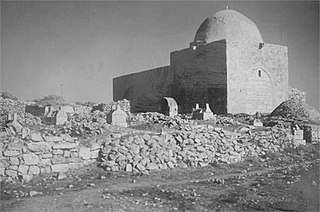
Rachel's Tomb is a site revered as the burial place of the Biblical matriarch Rachel. The site is also referred to as the Bilal bin Rabah mosque. The tomb is held in esteem by Jews, Christians, and Muslims. The tomb, located at the northern entrance to the Palestinian city of Bethlehem, next to the Rachel's Tomb checkpoint, is built in the style of a traditional maqam, Arabic for shrine.

Beit Jala is a Palestinian Christian town in the Bethlehem Governorate of the West Bank. Beit Jala is located 10 km south of Jerusalem, on the western side of the Hebron road, opposite Bethlehem, at 825 meters (2,707 ft) altitude. In 2017, Beit Jala had 13,367 inhabitants according to the Palestinian Central Bureau of Statistics. About 80% of the population were Christians and about 20% Muslims.

Deir al-Balah or Deir al Balah is a Palestinian city in the central Gaza Strip and the administrative capital of the Deir el-Balah Governorate. It is located over 14 kilometers (8.7 mi) south of Gaza City. The city had a population of 54,439 in 2007. The city is known for its date palms, after which it is named.

Saint George's Day is the feast day of Saint George, celebrated by Christian churches, countries, and cities of which he is the patron saint, including Bulgaria, England, Georgia, Portugal, Romania, Cáceres, Alcoy, Aragon and Catalonia.

Beit Sahour or Beit Sahur is a Palestinian town east of Bethlehem, in the Bethlehem Governorate of the State of Palestine. The city is under the administration of the Palestinian National Authority. The population was of approximately 14,000 in 2017, consisting of approximately 80% Christians and 20% Muslims.

The Catholic Church in Israel is part of the worldwide Catholic Church, in full communion with the Holy See in Rome.

Al-Khader is a Palestinian town in the Bethlehem Governorate in the south-central West Bank. It is located 5 kilometers (3.1 mi) west of Bethlehem. According to the Palestinian Central Bureau of Statistics, the town had a population of 11,856 in 2017. The area around al-Khader is marked by vineyards, and olive and fig trees.
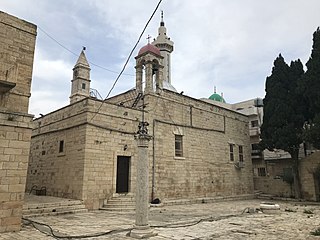
The Saint George's Monastery in Al-Khader or Church of Saint George in Al-Khader is an Eastern Orthodox Christian monastery in the Palestinian town of al-Khader, near Beit Jala and Bethlehem in the central West Bank. The town of Al-Khader is named after Saint George, who in Arab culture is known as "al-Khadr"; the church is considered the most important sanctuary to Khadr in Palestine.
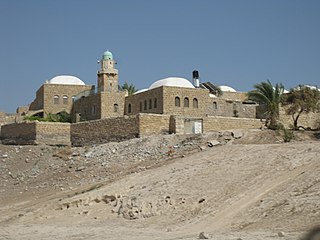
Nabi Musa is a mosque and a Palestinian locality in the Jericho Governorate of Palestine, in the West Bank, believed to contain the tomb of Moses according to tradition. It is also the name of a seven-day long religious festival that was celebrated annually by Palestinian Muslims, beginning on the Friday before Good Friday in the Orthodox calendar used by the Greek Orthodox Church of Jerusalem. Considered in the political context of 1920 as "the most important Muslim pilgrimage in Palestine", the festival centered on a collective pilgrimage from Jerusalem to what was understood to be the Tomb of Moses, near Jericho. A great building with multiple domes marks the mausoleum of Moses.

The Monastery of Saint George of Choziba, also known as Monastery ofChoziba or Mar Jaris, is a monastery located in Wadi Qelt in Area C of the eastern West Bank, in the Jericho Governorate of the State of Palestine. The cliff-hanging complex, which emerged from a lavra established in the 420s and reorganised as a monastery around AD 500, with its ancient chapel and irrigated gardens, is active and inhabited by Greek Orthodox monks. It houses the relics of saint George of Choziba, after whom the monastery is named, as well as the relics of saint John of Choziba.

An-Nabi Samwil, also called al-Nabi Samuil, is a Palestinian village of nearly 220 inhabitants in the West Bank, within the Jerusalem Governorate of the State of Palestine, located four kilometers north of Jerusalem. The village is built up around the Mosque of Nabi Samwil, containing the Tomb of Samuel; the village's Palestinian population has since been removed by the Israeli authorities from the village houses to a new location slightly down the hill.
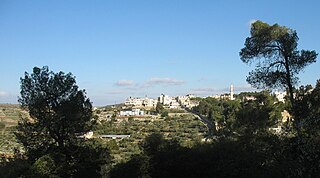
Al-Qubeiba is a Palestinian village in the Jerusalem Governorate, located 11 kilometers Northwest of Jerusalem in the central West Bank. According to the Palestinian Central Bureau of Statistics, the village had a population of 3,321 in 2010. Al-Qubeiba lies at an altitude of 783m to 795m above sea-level. It is located in a conflict area near the border with Israel between Ramallah and Jerusalem. The settlement of Giv'on HaHadashah lies 5 km southeast of al-Qubeiba. It is surrounded by the town of Biddu (east), Beit 'Anan (northwest), Qatanna (southwest), and Kharayib Umm al-Lahim (west). Unlike the surrounding region, al-Qubeiba has large areas covered with pine and olive trees.
Tourism in the Palestinian territories is tourism in East Jerusalem, the West Bank, and the Gaza Strip. In 2010, 4.6 million people visited the Palestinian territories, compared to 2.6 million in 2009. Of that number, 2.2 million were foreign tourists while 2.7 million were domestic. In the last quarter of 2012 over 150,000 guests stayed in West Bank hotels; 40% were European and 9% were from the United States and Canada. Major travel guides write that "the West Bank is not the easiest place in which to travel but the effort is richly rewarded."

Beit Jimal, Beit el Jemâl, meaning "The house of the camel" is a Catholic monastery run by Salesian priests and brothers near Beit Shemesh, Israel. The Christian tradition identifies the site with the Roman- and Byzantine-era Jewish village of Caphargamala, and believe that a cave there is the tomb of St. Stephen or to have conserved his relics. An alternative spelling and etymology for the name is therefore Beit Gemal or Beit Gamal - the House of Rabban Gamaliel the Elder.
Baraka Bible Presbyterian Church is a reformed and fundamental Bible Presbyterian church located in Bethlehem and Shepherd's Field. The first and only Bible Presbyterian Church in Israel, it is often attended by Pilgrims who visit the Holy Land. The sale of its original compound, Beit El Baraka, has been the subject of an international fraud case. The pastor is the Rev George Awad.
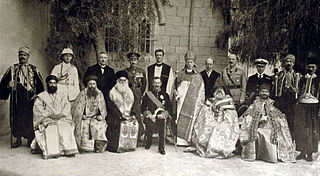
The Holy and Ancient Archdiocese of Jerusalem, All Palestine, and All the Near East or the Coptic Orthodox Patriarchate in Jerusalem, is a Metropolitan Archdiocese of the Coptic Orthodox Church, which is part of the wider communion of the Oriental Orthodox Church. It is headed by the Coptic Orthodox Metropolitan Archbishop of Jerusalem, the incumbent being Metropolitan Archbishop Antonious of Jerusalem since 2016. Its jurisdiction covers those Coptic Orthodox Christians living in the Near East; with churches and monasteries in the State of Palestine, the State of Kuwait, the Hashemite Kingdom of Jordan, the Lebanese Republic, the Syrian Arab Republic, and the Republic of Iraq. The adherents are largely of Coptic Egyptian descent, mainland Coptic migrants and their descendants. The archdiocese is based at St Anthony's Monastery, in the Christian Quarter of the Old City of Jerusalem, beside the Church of the Holy Sepulchre.





















